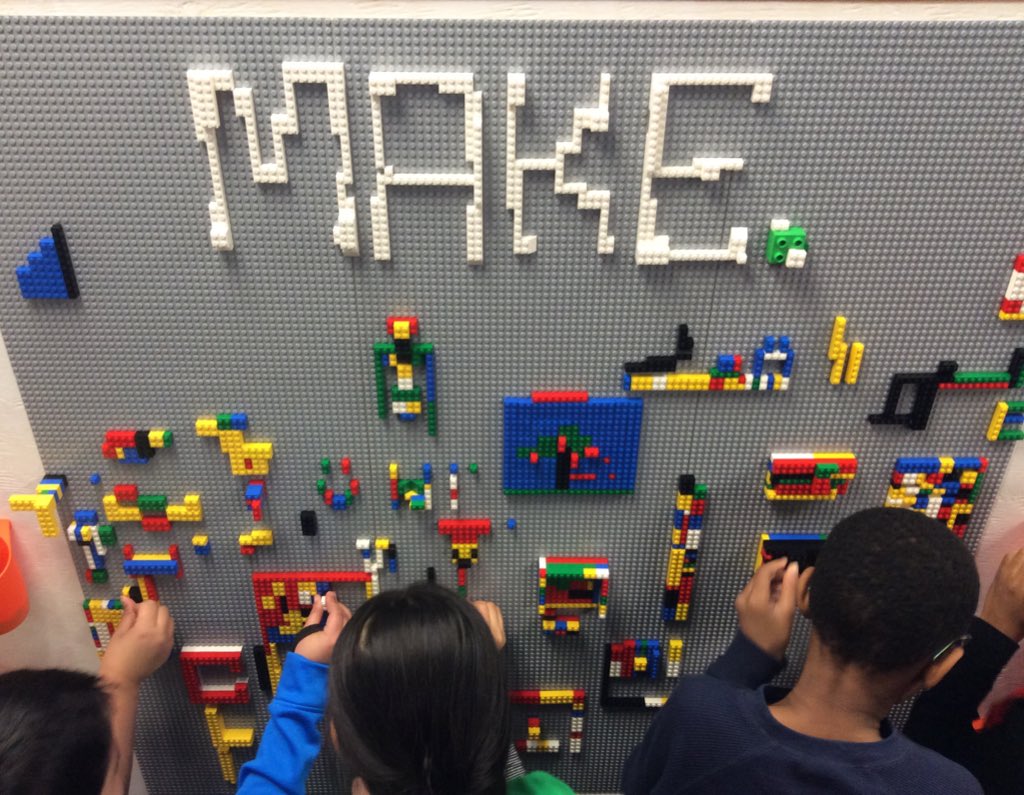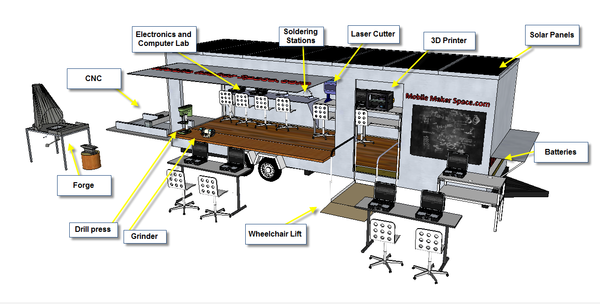This is an introduction to Makerspace in school libraries. The goal of a Makerspace is to facilitate making. I have explored various articles and books that I feel can assist in researching, preparing and building a Makerspace with varying levels of funding. The focus of making is to learn and ultimately create through doing, while tapping into technologies to do that. Making focuses on learning through “doing” in a social environment, or community; a place where students can develop new knowledge and skills contributing to their academic achievement.
As with all learning, making is not intended to be perfect. It means that students will learn through trial and error, or hands-on experience in a community setting. Makerspaces come in all shapes and sizes, some fixed rooms, others temporary. Incorporating Makerspace into a library simply makes the most sense, as part of a librarian's job is to promote literacy through instruction. Ultimately, libraries can provide access not only to information, but also hands on experiences which is necessary to become a citizen in the digital world.
Bagley, Caitlin A. Makerspaces: Top Trailblazing Projects : A LITA Guide. ALA TechSource, 2014. LITA Guide. EBSCOhost, moe.highline.edu:2048/login?url=https://moe.highline.edu:2596/login.aspx?direct=true&db=nlebk&AN=759504&site=ehost-live&scope=site.
This book is full of suggestions and ideas for both public and school libraries on how they can be a gathering place for young and old to learn how to create and build together as a community. It focuses on developing a community around shared use of space and equipment, as found in a library’s mission. The author analyzes nine Makerspaces all on varying budgets and describes their design and technology in depth. The guide answers questions about creating a Makerspace, breaking it down on how to target and market from ground up. It details how to register one, addresses usage policy and noise, funding, and software programs best suited for such space. This book does not need to be read from cover to cover, as one can select the sections that fit the institution such as school or public setting.
Graves, Colleen. “Starting a School Makerspace from Scratch.” Edutopia, 16 July 2015, www.edutopia.org/blog/starting-school-makerspace-from-scratch-colleen-graves. Web. Accessed 29 May 2017.
This article starts with the basics of how to start from scratch on building a Makerspace. The author suggests to immerse yourself in Maker Education; join a Makerspace somewhere in the community or one online, such as Camp Google. Get your hands dirty and go make stuff at a public library or community Makerspace. It is important to get others involved, create a steering committee to assist with purchasing decisions, goal setting, workshop ideas, and even Makerspace programming. Write grants, solicit PTA for funds, or even sign up for monthly grant opportunities from Mackin. Once your Makerspace is set up, it’s time to get students involved by hosting workshops or design challenges; engage them and make it appealing as they teach problem solving and creative thinking. Lastly, integrate the maker education into the curriculum so it incorporates what you are teaching in library.
Hamilton, Matthew, and Dara H. Schmidt. “Make It Here: Inciting Creativity and Innovation in Your Library.” Libraries Unlimited, 2015. Web. Accessed 29 May 2017.
This book is available in Ebook or print format. It provides a step-by-step guide on creating a Makerspace in your library and backs it up with instructions and ways to follow up to make sure you are successful. It takes you through the steps of starting a Makerspace, finding the “Makerspace mix,” having a well thought out plan, and working with a committee to have well thought out funding. The authors discuss why we should promote creativity in our library and dive into programming and operations as well. Much of what they write about is advice based off their own experiences with their Makerspaces, and other educators they have talked to throughout their journey.
Lister, Heather. “Create an Amazing Low-Tech Library Makerspace.” Ideas & Inspiration from Demco, Demco, 10 Apr. 2017, ideas.demco.com/blog/create-amazing-low-tech-library-makerspace-easy-ideas/. Accessed 29 May 2017.
Heather Lister addresses the dreaded pessimist who feels that creating a Makerspace requires money or space/devices to create one. She points out that technology is not a requirement to start a Makerspace; you can do it with items as simple as cardboard, plastic bottles, straws, glue, pool noodles, simple household tools, wire, dowels, tape, yarn beads, and much more. Take a look around your house or classroom and create tubs of items that will let the creative juices flow in the students. Don’t over think things; make it simple and lead by creating an example. Make it accessible by labeling so students can find things easily. Best advice she gives it to showcase students creations so others can get ideas of their own.

Lotts, Megan. "Playing with LEGO®, Learning about the Library, and “Making” Campus Connections: The Rutgers University Art Library Lego Playing Station, Part One." Journal of Library Administration, vol. 56, no. 4, May/June 2016, pp. 359-380. EBSCOhost, doi:10.1080/01930826.2016.1168252.
In this article, the author discusses the importance of outreach, creativity, and innovation to the future of academic libraries. Makerspaces have the opportunity to bridge a community with a school by creating making events that are appealing and engaging. She suggests keeping the activities to a low cost, as they can stimulate problem solving skills on a budget. Bringing LEGO® SERIOUS PLAY® is one way to bring hands-on learning experiences, which the author evaluates in this book to see if it was successful or not.
Martinez, Sylvia. “Help! There's a Makerspace in My Library!” At School Outfitters, School Outfitters, www.schooloutfitters.com/article/help-theres-a-makerspace-in-my-library. Accessed 22 Apr. 2017.
This article breaks down the basics of what a Makerspace should look like. It explores storage and what will be stored; materials/tools and projects, project storage, safety and security, and the best fit books to have on hand to assist students. The author suggests that each librarian will have a different type of way to store and classify the materials, such as grouping parts by similar size, shape, color, etc. Ultimately, the goal is for the students to see the choices they have as they make them. The article points out that an active Makerspace will eventually become a messy one and that is alright. But make sure your library has high expectations set for the students to pick up and reshelve materials, so the next student can dive in. Also discussed is the importance of employing proper safety precautions, from first aid kit and fire extinguisher, and thinking through project from start to finish to assure all measures are in place. Finally, the author suggests various books that will assist with the Makerspace, such as “how to” books, books on crafts and projects, cross-cultural books, artistic books, puzzles, computer and coding books, and MAKE magazines.
Moorefield-Lang, Heather. "When Makerspaces Go Mobile: Case Studies of Transportable Maker Locations." Library Hi Tech 33.4 (2015): 462-71. ProQuest. Web. Accessed 29 May 2017.
This paper’s goal is to cover creating and implementing mobile Makerspaces, locations that can move for a day, week or year at a time, in libraries and other educational settings. The author discusses the history of mobile Makerspace, dating as far back to bookmobiles, and goes into great depth covering the origin and growth over the years. This paper reports on six in-depth interviews with librarians and educators, K-12, public and university sector, who made decisions to go mobile with their Makerspaces; two in fully built trucks, one carried in a library van, two transported in school buses, one in a cart. This was a fabulous article as it showed how high school students are gaining teaching and outreach opportunities by providing a making environment for schools in district!
Peltier-Davis, Cheryl Ann and David Lee King. The Cybrarian's Web 2 : An A-Z Guide to Free Social Media Tools, Apps, and Other Resources. Information Today, Inc, 2015. EBSCOhost, moe.highline.edu:2048/login?url=https://moe.highline.edu:2596/login.aspx?direct=true&db=nlebk&AN=992498&site=ehost-live&scope=site.
This print or Ebook is geared towards “info pros who want to innovate, improve and create new library.” The reader will discover an abundance of great web resources and mobile apps supporting the latest trends in technology, from cloud storage, Ebooks, Makerspaces, and more, all tailored to the needs of libraries and the communities they serve. This book provides in depth summaries and analysis of free resources on the web and trending concepts successfully implemented by libraries. If you're looking for expert opinions and guidance on using free content, tools, and apps to help your library, this book is for you!
Preddy, Lesley. "Creating School Library "Makerspace"." School Library Monthly 29.5 (2013): 41-2. ProQuest. Web. Accessed 22 May 2017.
This article references that the school library is now a destination, due to Makerspaces being so popular. It goes in depth about creating a Makerspace, supplies needed, and laying out enough for a day so you can get through without direct supervision. The author emphasizes the importance of having creative freedom in the space, so they can learn through carrying forms of media. It covers that a Makerspace activity may be an original idea, something shared and found in an article book or website. Suggested Makerspace activities and equipment are also cited.
Range, Ellen and Jessica Schmidt. "Explore, Plan, Create: Developing a Makerspace for Your School Community." School Library Monthly, vol. 30, no. 7, Apr. 2014, pp. 8-10. EBSCOhost, moe.highline.edu:2048/login?url=https://moe.highline.edu:2596/login.aspx?direct=true&AuthType=ip&db=tfh&AN=97266188&site=ehost-live&scope=site.
http://moe.highline.edu:2048/login?url=https://moe.highline.edu:2596/login.aspx?direct=true&AuthType=ip&db=tfh&AN=97266188&site=ehost-live&scope=site
http://moe.highline.edu:2048/login?url=https://moe.highline.edu:2596/login.aspx?direct=true&AuthType=ip&db=tfh&AN=97266188&site=ehost-live&scope=site
This article offers guidelines on the development of a Makerspace with school communities. It points out that successful Makerspaces, balance “practicality with creativity and collaboration to serve the needs of the school community.” It covers a team of Michigan students who created a Makerspace and their experiences within the schools, most specifically a middle school. The authors discuss in detail space, storage and stuff, breaking down what recommendations they have. They also address another important step in creating a Makerspace is where to go for expert advice, and they talk about the “sherpas” the Michigan students created to be a sounding board.

Comments
Post a Comment